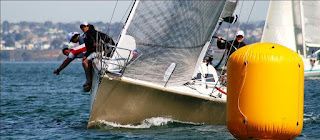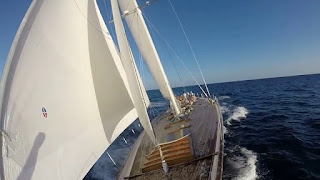
Rounding the Top Mark
In any race there are certain hot- spots where significant
distance can be gained or lost. One of these is in the vicinity of the top mark,
particularly on the first beat. The fleet is generally congested and tend to
arrive in a clump. It can be an area of anxiety where things go awry and have a
dramatic effect on our race.
We have this situation with the closing up of the fleet in a
concentrated area around the top mark with boats in close vicinity jostling for
position. Then we have to turn the corner amongst all this mayhem and set a
spinnaker which is a relative complicated manoeuvre in itself. Acute tactics, boatspeed and crew-work all
have a significant role to play.
Tactics
There are two aspects to the tactical consideration, the approach
and the exit. A good mark rounding’s merit is judged by the result that once
around you are heading where you want to go at reasonable speed in relatively clean air.
Approaching the top mark, keep clear lanes if you can. It is
not always possible as boats will tack in your wind giving you bad air. If this
scenario develops i.e. you have a group of boats just ahead. Start planning a
little way out, keep off the layline as long as you can in clearer air, and if
you have to get in the layline procession early then overstand a bit so when
inevitably someone tacks ahead you can keep your speed up. There is nothing
worse than sitting there struggling to get around the mark in bad air with boats
rolling over you.
The ability to pick a good layline is important. They will
vary enormously in different conditions, so unless you are very familiar with
your boat incorporate it in your preparation by picking a few marks or land
features to ascertain the tacking angles. It is also very important at a mark
rounding implementation to not get distracted by the presence of other boats around;
everyone just does their job. The steerer drives, the trimmers trim and the
tactician worries! Multiple boat lengths
can be won or lost.
On exiting the mark we have three options we need to
consider and decide. We can do a standard bear away set, we can gybe set or we
can do a bear away set with an early gybe. All three options should be
incorporated in your general training and your prerace warm up so your crew
know exactly what is required when the call is made.
Bear away set
The bear away set is the most common; approaching the mark
the spinnaker is hooked up and when the mark will be fetched without tacking,
then the pole can be raised into position or extended. After this a bit of the
brace on symmetric spinnakers or tack-line on asymmetric sails can be snuck
forward out of the bag to assist a quick set. Note, don’t pull out too much we
do not want it to set and pull the spinnaker out of the bag prematurely, just a
little to help the brace/ tack-line crew get the sail into position. As the
helmsman rounds the mark, the trimmers should ease the sails until the downwind
angle is reached, it can cause issues if the jib is eased too far as the
spinnaker can catch on the leech as it is hoisted stopping the brace / tack-line
being taken up. I like to see the spinnaker going up under the jib not behind
it. The cockpit crew should stay on the rail as long as possible and move into
positions and commence the hoist as soon as they hear the call. The mast man
manually hauls the spinnaker up with the pit man tailing. The bowman feeds the
spinnaker and then helps to pull the brace on. Once hoisted the mast man calls
done and the spinnaker is sheeted home. The headsail is then dropped. It can be
nice to have a “pit assist” to drop the headsail early to help the spinnaker set
quicker. With the exception of windy days I like to see the headsail coming
down as the spinnaker goes up.
Common mistakes on a bear away set are not bearing away
quickly and ending up wide of the mark allowing boats following to slide inside
you limiting your tactical options. On symmetric boats the brace trimmer needs
to be aware of exactly how far to wind back the pole, incorrect trimming of the
pole angle can lead to retarding the spinnaker set. If in doubt work on about
45 degrees as this will get the spin luff clear of the head sail and still allow
for a bit of forward apparent wind angle. On an asymmetric boat the helm will
have to steer low initially to facilitate the hoist and then higher to set the
spinnaker before bearing away and settling on optimum course. One more common
mistake is the spinnaker trimmer over sheeting the sail and not getting it out
“in front of the boat”. Don’t sheet in while the sail is being hoisted, just
pause and go at when the spinnaker is up. An over sheeted spinnaker is much
slower than an under sheeted one. Better
to wait and sheet it on to the apparent wind rather than pull it on before it
is fully set and wait for the wind to set it.
Gybe set
A gybe set is a good consideration for a few reasons, if the
wind has backed to the right as we approached the mark making the port gybe the
better option, we should always gybe set. Remember it is just as important to
sail the knocks downwind as working the lifts upwind. Also it can have better
tactical positioning as you are inside the rest of the fleet in clear air and able
to be more proactive in your tactics down the leg, not to mention you have an
increased chance of getting mark room at the bottom rounding if you are coming
from the left side.
If you want to implement a gybe set, it is important for the
tactician to get you the inside berth at the mark rounding. This will enable
you to gybe unimpeded without consideration for other boats. As the boat gybes
the main will be thrown across and the spinnaker hoisted, some people like to set
up the pole first but I would much rather develop the ability to set and fly
the spinnaker poleless and set it up after the spinnaker is set. It is much
faster and efficient (yes, that’s right, more training required until you can
do this). Some times this may even necessitate the use of a spare crew to act
as a “human pole” holding the brace out with outstretched arms until the pole
can be positioned. Relatively speaking a gybe set on an asymmetric boat is much
easier; nothing really changes with the process, just gybe and hoist.
Early Gybe
The standard hoist and early gybe are a consideration in
some circumstances. Particularly if a lot of boats are approaching the mark
behind you and to gybe quickly would put you in a hole formed by their wind
shadows, not to mention the choppy water caused by the close vicinity of so
many boats. It can be a benefit to hold on a bit, get your sail up and drawing
and then gybe in the relative comfort of clearer air and more stable
conditions. The priority here is to get the spinnaker up and drawing and the
headsail down and cleared away. A quick check of the lines and call “clear to
gybe “. The helmsman will need to steer a course to stop other boats getting on
your inside hip and stopping you gybing. So if you want an early gybe make sure
you sail as square as you can around the mark to give yourself a lane to gybe
into.
Rules and Harmony
Two extra points, as always it is absolutely necessity to
have a good working knowledge of the rules whenever you put yourself in a
position in close proximity of other boats. So learn them! The other which is a
cause of consternation is the late call by the afterguard to change from one
option to another at the last minute. A lot of crew get annoyed when this happens.
The reason the call is made is because circumstances have changed. The after
guard will have taken into account the hassle and have decided it is still the
best option despite the time lapse caused. I would much rather be going the
right way a little slower than flying off on a tangent at great speed.
So work hard at your mark rounding’s, many is the time I
have been on boats well placed just to see it all lost at the distraction
caused by the fleet congesting at the top mark.



Comments
Post a Comment